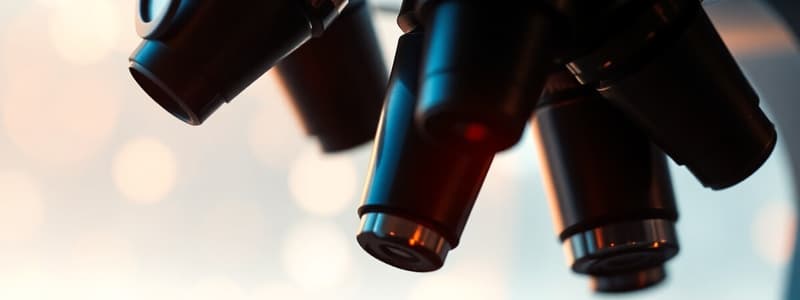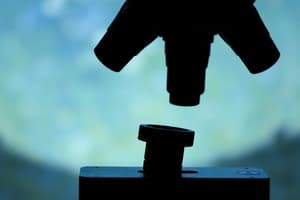Podcast
Questions and Answers
Which of the following adjustments should typically be made first when wanting to adjust the light intensity of a microscope?
Which of the following adjustments should typically be made first when wanting to adjust the light intensity of a microscope?
- Adjusting the rheostat. (correct)
- Adjusting the fine focus knob.
- Adjusting the iris diaphragm lever.
- Adjusting the coarse focus knob.
A student is observing a specimen under a microscope. They switch from a 10x objective to a 40x objective. What adjustments will likely need to be made?
A student is observing a specimen under a microscope. They switch from a 10x objective to a 40x objective. What adjustments will likely need to be made?
- Increase the light intensity and open the iris diaphragm to maintain brightness and resolution. (correct)
- Decrease the light intensity and close the iris diaphragm to reduce the field of view.
- Increase the working distance and close the iris diaphragm to sharpen focus.
- Decrease the light intensity and open the iris diaphragm to increase contrast.
A researcher is designing an experiment to test the effect of different concentrations of a fertilizer on plant height. What represents the independent variable in this experiment?
A researcher is designing an experiment to test the effect of different concentrations of a fertilizer on plant height. What represents the independent variable in this experiment?
- The concentration of fertilizer applied. (correct)
- The height of the plants after a set period.
- The amount of sunlight the plants receive.
- The type of plant used.
Which of the following is the most important reason for using a control group in an experiment?
Which of the following is the most important reason for using a control group in an experiment?
In the context of microscopy, what does 'parfocal' mean?
In the context of microscopy, what does 'parfocal' mean?
When observing a sample using a microscope, the image appears blurry even after fine adjustment. Which factor is least likely to be the cause?
When observing a sample using a microscope, the image appears blurry even after fine adjustment. Which factor is least likely to be the cause?
A student prepares a wet mount of plant tissue and observes it under a microscope. They notice the image is dark and lacks contrast. To improve the image, which adjustment should the student make?
A student prepares a wet mount of plant tissue and observes it under a microscope. They notice the image is dark and lacks contrast. To improve the image, which adjustment should the student make?
Why is it important to use only the fine focus knob when using high power objectives on a microscope?
Why is it important to use only the fine focus knob when using high power objectives on a microscope?
When preparing a wet mount of leaf tissue to observe stomata, why is it important to use a thin layer of clear nail polish on dry leaves?
When preparing a wet mount of leaf tissue to observe stomata, why is it important to use a thin layer of clear nail polish on dry leaves?
A student is examining stomata on a leaf cast under a microscope. They observe that the guard cells appear turgid and round. What can the student infer about the plant's condition?
A student is examining stomata on a leaf cast under a microscope. They observe that the guard cells appear turgid and round. What can the student infer about the plant's condition?
Flashcards
Mechanical Stage
Mechanical Stage
The platform on which microscope slides are placed.
Ocular or Eyepiece
Ocular or Eyepiece
Lens through which objects are viewed.
Objective
Objective
Lens that magnifies the object.
Iris Diaphragm
Iris Diaphragm
Signup and view all the flashcards
Coarse Adjustment
Coarse Adjustment
Signup and view all the flashcards
Fine Adjustment
Fine Adjustment
Signup and view all the flashcards
Rheostat
Rheostat
Signup and view all the flashcards
Resolving power
Resolving power
Signup and view all the flashcards
Magnification
Magnification
Signup and view all the flashcards
Independent variable
Independent variable
Signup and view all the flashcards
Study Notes
Microscope Basics
- Microscopes are used to observe objects too small to see with the naked eye.
- Proper microscope handling involves grasping the arm with one hand and supporting the base with the other.
- The mechanical stage is the platform where microscope slides are placed.
- The path viewed goes through the ocular or eyepiece, then through the lens of the objective.
- Compound microscopes typically have binocular eyepieces and multiple objectives: scanning (4x), low power (10x), and high power (40x).
- The condenser focuses light onto the slide, while the iris diaphragm regulates the amount of light.
- Major adjustments are done with the coarse adjustment knob, minor with the fine adjustment knob.
- The rheostat adjusts the intensity of light, and the iris diaphragm can also influence light levels.
Resolution and Magnification
- Resolution describes the ability to distinguish between closely spaced points.
- High resolution results in a sharp image.
- Human eye's resolution is about 0.1 mm.
- Shorter light wavelengths, like blue light, enhance resolution.
- Best compound microscopes have a resolution of about 0.2 µm.
- Opening the iris diaphragm can increase resolution but may reduce contrast.
- Magnification is how much larger an object appears compared to its actual size.
- Total magnification is the product of the ocular and objective lens powers (e.g. 10X ocular and 10X objective yield 100X magnification).
- Excessive magnification beyond the resolution limit does not improve clarity
Experimental Design
- Experimental design is how one tests a hypothesis through experimentation.
- A strong design yields reliable conclusions about cause-and-effect relationships.
- Experiments involve independent, dependent, and controlled variables.
- The independent variable is what the researcher changes.
- The dependent variable is affected by changes in the independent variable.
- Controlled variables remain constant to ensure the change is only due to the independent variable.
- A control group does not receive the experimental treatment.
- Charts and graphs help to represent data.
- Typically, independent variables are on the x-axis and dependent variables on the y-axis.
- Continuous independent variables are suited to scatter plots, while discrete variables are suited to column charts.
Leaf Stomata
- Plants exchange gases via stomata for photosynthesis
- Stomata are surrounded by guard cells
- When guard cells are turgid (filled with water), the stoma opens
- Open stomata allow plants to exchange CO2 and O2
- When guard cells are flaccid, stomata close
- Closed stomata reduce water loss and also gas exchange
Microscope Usage
- Clean microscope lenses with lens paper moistened with water.
- Start observations with the scanning objective (4x).
- Adjust the stage using the coarse adjustment knob.
- Adjust the interpupillary distance using the knob between the oculars.
- Focus each eyepiece separately to correct for vision differences.
- Note the adjustment on the ocular for future ease of use.
- When moving the slide left, the image moves to the right and vice versa
- Microscopes should be parfocal, in focus with low power and almost in focus with higher power.
- You can bring the object into focus using only the fine adjustment.
- As magnification increases, the field of view and working distance decrease and image brightness decreases.
- Adjust rheostat or iris diaphragm for light as magnification increases.
- The depth of field decreases at higher powers.
- Locate objects under the lowest power before increasing magnification.
Wet Mounts and Dissecting Scopes
- Wet mounts involve placing a liquid drop on the slide, adding the specimen, and covering with a coverslip.
- The cover glass should be lowered at an angle to prevent bubbles
- Depth of field is the vertical distance that remains in focus at one time
- Dissecting microscopes use reflected light.
- Dissecting microscopes have a larger depth of field.
Stomata Experiment
- Use nail polish to make a cast of cells from a leaf
- Apply nail polish to dry section of the leaf
- Use tape to peel off for the sample leaf cast for viewing
- Count all stomata that are at least half visible
- Stomata are considered open if guard cells are turgid
- Repeat the count at least 3 times per sample
- Use excel to do an experimental design and data presentation
- Ensure to correctly store away microscope to avoid point deuductions
Studying That Suits You
Use AI to generate personalized quizzes and flashcards to suit your learning preferences.




